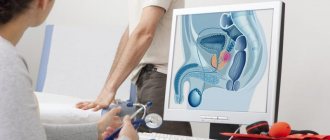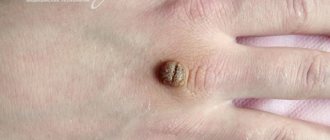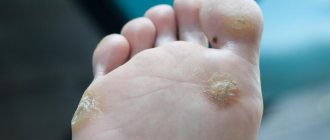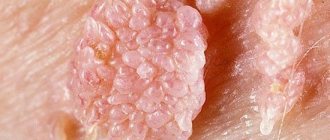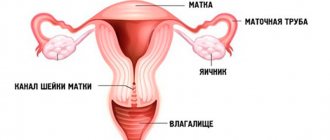Warts, or medically called viral warts, are benign skin growths that occur due to infection with the human papillomavirus (HPV). After HPV enters the skin, it actively multiplies in the superficial and deep layers of the dermis, resulting in warts.
Considering the viral nature of the appearance of formations and the absence of specific pathogenetic drugs against HPV, the only way to get rid of warts is to remove them! There are no other treatment options yet. In addition, removing warts is the most reliable way to prevent their further spread.
Warts can be localized on various areas of the skin of the face and body. They can occur both in older people and at a young age.
Warts are usually not accompanied by any symptoms, but can grow quickly, especially with constant trauma (for example, on the sole), actively spread and appear even on the face.
In addition, the presence of warts can cause not only physical, but also psychological discomfort, especially if they are localized on exposed parts of the face and body.
Causes of warts
The main cause of warts on the human body is the human papillomavirus (HPV), which is very common and highly variable. In total, more than one hundred and fifty types of HPV are known, but only a few of them lead to the appearance of warts. The background that provokes HPV infection and the development of tumors on human skin are the following factors:
- Weakened immunity.
- Chronic diseases.
- Constant stress.
- Poor nutrition.
- Damage and diseases of the skin.
The “gate of entry” for HPV can be microtraumas - wounds, abrasions and cracks in the skin. Therefore, the method of transmission of the virus into the human body can be carried out by touching the patient or using the same objects with him - for example, a computer keyboard. You can often catch the virus in a bathhouse, swimming pool or gym.
Another source of infection is sick animals. Workers involved in cutting meat or fish are especially at risk; when infected, their hands, fingers and forearms are most often affected.
Warts grow quickly and can spread across the skin. If a neoplasm is injured, there is a possibility of spreading and new forms appearing on the skin. In addition, with frequent trauma, constant pain occurs in the area of the wart, which can cause physical discomfort. If you self-medicate, scars may remain on the skin. In addition, with constant trauma, warts can become malignant.
Are toads to blame? Why do warts appear in children?
Anoint them with celandine... Or maybe garlic? Or take magnesium internally?... People go to great lengths to get rid of them. We are talking about the treatment of warts. Are the traditional medicine methods that the Internet is replete with justified, or is it still better to consult a specialist?
We talked about what warts are, why they occur, how to treat them correctly and prevent their appearance with Vladislav Leonidovich Sheinkman, candidate of medical sciences, dermatovenereologist at the Expert Tula Clinic.
— Vladislav Leonidovich, what are warts and what types of warts are they?
Warts are an infectious pathology caused by the human papillomavirus. There are several varieties of them. These are vulgar (or ordinary), flat, plantar warts, genital warts. Molluscum contagiosum can be included in this group.
Read the material on the topic: What is herpes? How to recognize it and cure it?
— What is the difference between warts and other neoplasms? For example, can a wart be confused with a mole?
They differ both in appearance and microscopically. The average person may confuse a wart and a mole, but a dermatologist cannot.
Therefore, when any formations appear on the skin, in order to avoid misdiagnosis, you should, firstly, always contact a dermatologist, and secondly, never self-medicate (which, unfortunately, often occurs in practice).
- What causes warts to appear?
The causes of warts are numerous. This is a weakening of the immune system; the presence of microtraumas, cuts, cracks in the skin; sweating of the hands (if warts are on the hands); failure to comply with personal hygiene rules; bad habits (smoking, drinking alcohol); unbalanced diet, hypovitaminosis; non-compliance with sleep and rest schedules; some hormonal disorders; living in regions with unfavorable environmental conditions.
Warts are viral in nature and can be infected. This is possible through a handshake, using other people's things and personal hygiene products (for example, clothes, gloves, manicure accessories), in public places (transport, various institutions, swimming pools, beaches, etc.).
Genital warts are classified as sexually transmitted diseases. Therefore, transmission of the virus in this case occurs through sexual contact.
Read material on the topic: Cytomegalovirus, toxoplasmosis, syphilis, hepatitis B, rubella... What are the dangers of TORCH infections?
— How does the papilloma virus enter a child’s body?
Through microdamages on the skin (this is the “entry gate” for the virus). Children can have warts on their fingers and generally on their hands and feet. In adults, the same location, plus the genital area. Having appeared in one place, warts have a tendency to spread to other areas of the skin.
— Many people are carriers of the human papillomavirus, but not everyone develops warts. Why do some children and adults get warts and others do not?
Indeed, it happens that a person will never have warts in his entire life. As I said earlier, there is a connection between the state of immunity (both general and local) and the appearance of warts. The presence of concomitant diseases and environmental factors is important. For example, if a child often suffers from acute respiratory infections, his antiviral immunity is weakened, and the body “meets” the human papillomavirus, then the risk of infecting the child with it increases.
Read the material on the topic: Are unvaccinated children the healthiest?
— What is the incubation period for warts?
It ranges from several days to several months.
— Various forums on the Internet sometimes offer exotic methods of treating warts. For example, there are those who claim that you can get rid of warts with the help of celandine. Others say that an apple that needs to be buried in the ground will help. Are traditional methods of treating warts really effective?
The treatment of warts is based on destructive methods (i.e. methods aimed at destroying them).
Traditional methods based on destruction can help eliminate the wart. The problem is that, unlike standardized medical removal methods, when using traditional methods there is a possibility of both under-treating and “overdoing” when performing the removal procedure. In the first case, the infectious tissue of the wart will not be completely removed, and in the second there will be excessive tissue damage, excessive burns and the formation of rough scars at the site of exposure. And, most importantly, this does not always lead to results.
In my opinion, the use of such methods harms the patient, and does not relieve him of the problem.
— What can you say about the removal method when the wart is tied with thread?
This should not be done.
— Vladislav Leonidovich, is it true that warts can go away on their own?
This happens occasionally. This is due to the state of the immune system.
Read the material on the topic: What does immunity depend on?
— How are warts treated?
Treatment begins with destructive methods. There are several of them. Among them are cryodestruction with liquid nitrogen, laser removal using the Surgitron apparatus, and electrocoagulation. There is also a removal method using certain acids.
I prefer to use liquid nitrogen. One of its advantages is that you do not need to numb the wart first. A bubble forms at the site of exposure, which then dries up, and the “crust” subsequently disappears. If the wart is large, it is advisable to perform the procedure 2-3 times (layer-by-layer removal).
You can make an appointment with a dermatologist in your city here. Please note: the service is not available in all cities
During laser removal, anesthesia is first performed, and then the wart is “cauterized.” Removing it is painless.
If local treatment is ineffective, recurrence or multiple warts are also prescribed, immunomodulators and some antiviral drugs.
— Which wart removal is more effective: laser or liquid nitrogen?
Both methods are effective, but I start with liquid nitrogen. If this is not enough, then laser wart removal is used.
— Do any warts require mechanical removal?
No. For example, if there are 1-2 flat warts, they can be removed. If there are many of them, and they are located on the face and open parts of the body (for example, the back of the hands), then antiviral ointments are prescribed locally and systemic treatment.
— After removing warts, is there a scar left?
It depends on the individual characteristics of the skin. For example, some individuals have a tendency to form so-called keloid scars after any exposure. Therefore, before removal, we always interview our patients in detail.
The depth of the wart is important, as well as the method of removal (in particular, liquid nitrogen acts more superficially, laser - more deeply).
Read material on the topic: What is demodicosis: symptoms, diagnosis and treatment
Sometimes, when a wart was diagnosed in the initial stages of development, if it is properly removed, no traces remain on the skin.
— Why do new formations appear after wart removal? How to avoid this?
Since the incubation period can fluctuate greatly, new formations may in fact not be new: some warts appear earlier, others later.
Secondly, there could be microtraumas on the skin, where the virus from the “mother” wart could have penetrated, including after its incomplete removal.
— Why are warts dangerous? Can they develop into cancer?
This is a source of infection - both for the patient himself and for others. They do not turn into cancer.
— How to protect a child from viral warts? What is the prevention of warts?
It is simple and consists mainly of observing the rules of personal hygiene. After visiting public areas, try to wash your hands. Do not use other people's personal belongings, even within the family. Visit beauty salons with a good reputation. Handle personal care items (manicure sets, etc.).
More of our articles without advertising are on social networks: VKontakte, Facebook, Odnoklassniki
Carry out general strengthening procedures. Follow a daily routine, get plenty of rest, get enough sleep, and eat rationally. Get rid of bad habits.
Other questions:
How to treat chickenpox in children?
How to help your child not be afraid of injections?
What can you get infected on vacation? Watch out for malaria!
For reference:
Sheinkman Vladislav Leonidovich
Graduate of the Pediatric Faculty of Smolensk State Medical Institute in 1994
From 1994 to 1995, he completed an internship, and from 1996 to 1998, a clinical residency in the specialty “Dermatovenereology.”
Has an academic degree of Candidate of Medical Sciences
Currently working at Clinic Expert Tula LLC as a dermatovenerologist. Provides reception at the address: st. Boldina, 74
Wart removal methods
Our clinic offers the widest range of equipment and methods for removing viral warts: radio wave, diathermocoagulation, laser. In the presence of large conglomerates of viral warts, cryodestruction (use of liquid nitrogen) is used at the first stage of their removal.
Modern methods for removing warts are simple, fast and affordable, and do not require preparation or additional tests.
- Removal of warts using the Surgitron device – removal using surgical radio waves. This device is actively used in various areas of surgery. The principle of operation of the Surgitron device is the non-contact effect on tissues of radio wave energy, which leads to an increase in temperature in the cells and their evaporation. Among the advantages of the method are rapid wound healing and minimal scarring.
- Removal of warts using the Fotona SP Dynamis – Nd: YAG laser. The laser beam selectively affects tissue, heats the cells and evaporates the liquid from them. Laser wart removal is performed layer by layer. The crust that forms on the surface of the wart is removed, after which the laser is applied again. The procedure is repeated until the tumor completely disappears.
- Removal of warts with plasma using the Plasmaskin device is one of the types of electrocoagulation - diathermocoagulation. Only the plasma exposure temperature in this case is about 2500 °C, therefore, to effectively evaporate pathological cells, it is enough to bring the electrode to the problem area at a distance of 1 to 5 mm until an electric arc is generated. That is, the removal procedure is carried out contactlessly. In addition, high temperature helps destroy HPV, which can cause relapse.
Warts
Treatment of warts
To get rid of a wart, you need to consult a dermatologist.
Treatment is carried out in a limited number of cases. The indication for wart removal is usually considered to be a visible cosmetic defect, discomfort, pain (in the presence of palmoplantar warts). Cryotherapy for warts is carried out using liquid nitrogen. The procedure takes place on an outpatient basis and does not require anesthesia. Minor pain and discomfort may occur. Extremely low temperatures freeze the wart tissue and cause necrosis. The effectiveness of the procedure reaches 50%. Several visits may be required. The advantage of the procedure is a good cosmetic effect: if performed correctly, there are no scars.
Electrocauterization of warts is carried out using an electrocoagulator - a device that creates a high-frequency current. This releases a large amount of heat, cauterizing and destroying tissue. The procedure is performed under local anesthesia on an outpatient basis. The wart is cut off at the root. If the procedure is performed correctly, there are no scars.
Laser wart removal is performed under local anesthesia. The procedure is performed on an outpatient basis. The laser beam evaporates the tissues that make up the wart layer by layer. If the procedure is performed correctly, there are no scars.
Surgical removal of warts is rarely used. The indication for surgery is the large size of the formations and the need for histological examination. The area of skin with the wart is excised with a scalpel, and the wound is sutured with cosmetic sutures. After the operation, almost invisible scars remain.
An alternative to invasive treatment may be the local use of antiviral ointments (interferon, oxoline, acyclovir), keratolytics (salicylic acid, tretinoin), chemicals (silver nitrate, podophyllin, trichloroacetic acid, alkalis). Effectiveness varies from case to case. In severe situations, systemic therapy may be required (immunomodulators, immunocorrectors, immunostimulants, antiviral drugs).
Prognosis for warts
Healthy people with a normal level of immunity have a favorable prognosis. Complications of warts in the form of dissemination, relapses, and secondary infection are observed relatively rarely.
How is the procedure performed?
The wart removal procedure is performed on an outpatient basis on the same day of treatment. The patient is first examined and advised by a doctor from our clinic in Moscow. Once the nature of the neoplasm is confirmed, as well as taking into account its size and location, removal is carried out using one of the optimally suitable methods. The procedure begins with local anesthesia. For this, Ultracaine injections or a special cream that is applied to the skin can be used.
After removal, the bed of the coagulated wart is treated with Fukortsin solution. In cases of a widespread process, medications that stimulate the immune system may be prescribed.
Skin care after wart removal
At the site of the removed wart, a scab (crust) is formed, under which the processes of epithelization and tissue healing will take place. Therefore, during the first 24 hours after the procedure, it is extremely undesirable to wet the removal site. In terms of daily care, it is necessary to treat the scab with Fukortsin solution until it is rejected on its own. You cannot pick or cut off the crust - complications are possible.
As a rule, small warts are removed simultaneously in one procedure. However, in the case of large tumors or their conglomerate, recurrence of the wart and its repeated removal are possible.
Relapse after removal of skin basalioma WILL BE CURED without surgery!
Afanasyev Maxim Stanislavovich.
Doctor of Medical Sciences, Professor of Sechenov University, oncologist, surgeon, oncogynecologist, gynecologist-immunologist, expert in the treatment of recurrent basal cell carcinoma.
"I am 51 years old. 4 years ago, a basal cell carcinoma was removed with a laser on my face. A year ago she appeared again, in the same place. I really don’t want to cut it out again, the scar is very noticeable, on the cheek near the nose. The size is about 1 cm. I work every day, constantly communicate with people, I need to remove it, preferably in the least traumatic way.”
Patients with repeated basal cell carcinomas after their removal are increasingly turning to me. Indeed, this is a huge problem that is becoming more acute year after year.
In addition to the fact that the incidence of basal cell carcinoma is increasing, most often this tumor occurs on the face, neck or head, where repeated use of any radical treatment method is associated with the loss of an organ or part of it. For this reason, treating relapse with traditional methods is often simply impossible.
The eyelash growth area is one of the most difficult. Recurrence of basal cell carcinoma in this area will raise very serious questions for the patient and his surgeon. Source: www.tabanmd.com
In my practice, I use photodynamic therapy to treat relapses after radiation or relapses after surgery.
It specifically eliminates altered cancer cells and does not affect healthy tissue. Even against the background of a significant tissue deficit in the relapse area, this allows for almost non-invasive and maximally aesthetic interventions.
In this article I will analyze the causes of relapses. I will give statistics on the effectiveness of different treatment methods and tell you how to save the situation if basal cell carcinoma develops again.
Basalioma of the chin after excision and healing. Source: metro.co.uk
Risks of recurrence of basal cell carcinoma - what is the likelihood of encountering it again after removal?
Cutaneous basal cell carcinoma, or cutaneous basal cell carcinoma, or BCCC, is a skin cancer. It extremely rarely metastasizes, but has a high tendency to relapse.
According to various sources, the incidence of relapses within 3-12 months after treatment is 21%. And over a period of 10 years, the tumor recurs in 40-46% of cases.
Unfortunately, when deciding to remove basal cell carcinoma (and doing the right thing), few doctors and patients plan intervention tactics taking into account possible relapse.
When agreeing to one or another method of treating basal cell carcinoma, you need to take into account one fact that is well known to doctors: any treatment is a provoking factor. The therapeutic effect on the tumor itself stimulates its activity and growth if the intervention is not radical enough.
This approach leads to the fact that treatment of recurrent basal cell carcinoma in the future either turns out to be impossible, or is associated with crippling and disfiguring loss of part of the nose, cheek, eye, ear... And such cases of long-term ineffective treatment of basal cell carcinoma are not uncommon. See for yourself.
The photo was taken immediately after removal of the basal cell carcinoma and after healing. Source: todddunn.files.wordpress.com
Therefore, when deciding on the choice of treatment method for basal cell carcinoma, it makes sense to consider several factors:
- The method guarantees a high degree of radicality of treatment - it allows you to completely remove all tumor cells, including the “root” of basal cell carcinoma.
- Preserves the integrity of the organ - eye, nose, ear, lips, etc.
- Provides minimal cosmetic defect (for example, all surgical methods require excision of an additional 2-5 mm of tissue from the tumor border).
- There are no long-term complications from using the method itself (it is believed that several years after radiation therapy, irradiated cells sometimes degenerate into cancer cells).
These are the properties that the photodynamic therapy (PDT) method has. It allows you to specifically eliminate all tumor cells without affecting healthy tissue, and in the vast majority of cases, obtain a relapse-free result in one procedure.
When treating a relapse, PDT does not require the removal of healthy tissue and preserves the integrity of the organ.
Risk factors for relapse
The high frequency of recurrence is associated with the characteristics of the tumor - basal cell carcinoma does not have a capsule, its real boundaries exceed the visible ones, and it is very difficult to determine the depth of invasion.
Here is a far from complete list of factors for relapse of basal cell carcinoma:
- Tumor shape. The nodular-ulcerative form of BCC recurs more often.
- The depth of tumor “growth” into the tissue. The surgeon sees only the affected area on the skin, but does not understand how deep the tumor goes. Tumors with deep invasion recur more often. Tumors with intradermal spread have the best prognosis.
- Tumor size. Relapses more often develop after treatment of tumors larger than 2 cm, so you should not “grow” moles on your face. In this case, basalioma cells can be detected at a distance of up to several centimeters from the lesion on healthy skin.
- Age and health conditions. Concomitant diseases can reduce immunity, which aggravates the course of the malignant process.
- “Inconvenient” location of basal cell carcinoma in anatomical folds and in close proximity to vital organs. These are the nose, nasolabial folds and ears. The tumor recurs slightly less often in the area around the eyes and in the eyelash growth area. Complete radical removal in these areas is simply impossible due to the risk of organ dysfunction or facial disfigurement.
- Different areas of the face have significantly different thicknesses of the skin and subcutaneous fat, which also affects the nature of the tumor and has a great influence on the choice of treatment method.
- Inadequate choice of treatment method or repeated treatment with different methods. This is the most important risk factor.
Many different methods are used to treat basal cell carcinomas. Unfortunately, none of them guarantee a 100% cure. Below I present a forecast for the development of relapse within 5 years after treatment, drawn from various sources:
- Close-focus X-ray irradiation (close-focus X-ray therapy). Recurrence of basal cell carcinoma after irradiation occurs in 46% of cases.
- PDT produces relapse in 6% of cases.
- Surgical excision. Relapse after removal of basal cell carcinoma develops in 30% of cases.
- Cryotherapy. The inability to control the depth of impact causes the largest number of relapses – 35%.
- Laser coagulation – 31%.
- Micrographic surgery according to Mohs. This is a relatively new method, which is still poorly represented in Russia, so it is still difficult to show the frequency of relapses.
- After previous combination treatment, repeated relapses occur in 47% of cases.
According to research results, vaporization, which is popular today (a method of treating basal cell carcinoma with a laser), turns out to be one of the least effective methods. According to this indicator, it is approaching cryodestruction.
The most effective method is still surgical excision of basal cell carcinoma. But, as we see, the effectiveness of the procedure is accompanied by a noticeable loss of healthy tissue.
What are the dangers of recurrent basal cell carcinoma on the face and head?
Recurrence of basalioma on the nose, as well as recurrence of basalioma on the lip, is fraught with the need for mutilating surgery. Since any surgical excision is carried out with the obligatory capture of 6 mm of healthy tissue, repeated removal of basal cell carcinoma on the nose usually ends with the removal of part of the nose and requires complex plastic surgery of the nose with tissues from other parts of the body.
Scope of surgery for nasal basal cell carcinoma. Source: www.ohniskin.com
The location of basal cell carcinoma in the corners of the eye is generally a contraindication to surgery, since in most cases it ends in the loss of the organ.
Source: www.tabanmd.com
Surgical excision of basal cell carcinoma on the forehead and scalp is complicated by the lack of subcutaneous fat in these areas. Excision of basal cell carcinoma involving healthy tissue leads to the impossibility of suturing the wound and requires the application of a skin flap from the patient's thigh.
Close focus X-ray therapy (FRT) cannot be performed on the ear. This leads to perichondritis - painful suppuration and swelling of the ear. The same procedure cannot be performed on the upper and lower eyelids, or exclusively using a special ocular prosthesis. Many patients report decreased vision after BPRT.
The bottom line, as we see, is that repeated treatment is often simply impossible.
Signs of relapse
80% of relapses occur between 3 months and 1 year after treatment. The remaining 20% - within 5-10 years. Therefore, recovery can be judged no earlier than 5 years after the procedure.
A relapse appears in the same place where the primary basal cell carcinoma was removed. Thus, recurrence of basal cell carcinoma after excision occurs directly in the scar.
What symptoms suggest a relapse? Repeated basal cell carcinoma looks like a non-healing wound or a new formation similar to the previously removed one.
If the formation appears on a new area of skin, it is a new basal cell carcinoma, which is not considered a relapse.
Is relapse treatable?
In the vast majority of cases, basal cell carcinoma is completely curable. The PDT procedure allows me to provide aesthetic and disease-free treatment of basal cell carcinoma in one procedure.
Treatment of recurrent basal cell carcinoma using PDT is performed with tissue preservation and has almost no risk of relapse.
I treat recurrent basal cell carcinoma using PDT. Based on my experience, I can say that basal cell carcinoma can be treated, and is treated extremely successfully.
I strongly recommend that all my patients always choose PDT as a priority treatment method. And that's why:
- This is a gentle, non-surgical and effective organ-preserving method of treating relapses.
- Selectively destroys the tumor while preserving healthy tissue.
- Does not require hospitalization.
- Well tolerated even by older people.
- There are practically no contraindications for people with concomitant diseases, for whom traditional treatment is associated with the development of complications.
- PDT is a non-toxic method: the photosensitizer does not cause significant changes in blood parameters.
- Has no serious complications.
- Can be used multiple times.
- Perhaps the only method of treating patients with a frequently recurrent form of the disease.
- One of the few methods for treating hard-to-reach neoplasms and tumors located in close proximity to vital organs.
- Allowed if there are contraindications to other methods.
- The author's development makes it possible to treat even complex localization of basal cell carcinoma in the eyes without the risk of weakened vision.
- Low risk of relapse.
- In the vast majority of cases, one PDT session is sufficient to eliminate the tumor.
Of course, it is better to use photodynamic therapy as the first method of treating basal cell carcinoma, but even for the recurrent form, my author’s protocols show very good results. Even if the blood flow in the scar is impaired, photodynamic reactions have a reserve in terms of the depth of impact: tumors with a scar of up to several millimeters will still fall under photochemical reactions indirectly through ischemic necrosis around the scar.
To get advice on whether photodynamic therapy is indicated for you, and to calculate the price of the procedure, send your medical history and tests by e-mail or call by phone in Moscow.
The reception is conducted by Afanasyev Maxim Stanislavovich - oncologist, immunologist, oncogynecologist, doctor of medical sciences, professor and member of the academic council of the First Moscow State Medical University named after. THEM. Sechenov Ministry of Health of the Russian Federation, expert in the treatment of basal cell carcinoma.
Reception is carried out in two clinics in Moscow, as well as in St. Petersburg, Makhachkala, Kursk, Stavropol, Barnaul, Samara, Naberezhnye Chelny, Salavat, Chelyabinsk, Surgut and other regions of Russia. You can check the date, location of the appointment in your city and sign up for a consultation with the administrator by calling 8-800-555-77-26.
After treatment, I maintain feedback with all patients and resolve any issues that arise. Hepatitis and positive HIV status are not contraindications for treatment with PDT.
References:
1. Chuprov I.N. Features of recurrence of basal cell skin cancer // Materials of the All-Russian conference with international participation: 100th anniversary of the Russian Society of Pathologists. St. Petersburg, 2009. pp. 345-347.
2. Panova I.E. Recurrence of basal cell cancer of the skin of the eyelids // Breast Cancer. Appendix Clinical ophthalmology. 2006. T. 7, No. 1. P.11-14.
3. Savelyeva A.E. Risk factors for the development of relapses of basal cell skin cancer: abstract. dis. ...cand. honey. Sci. M., 2004. 24 p.
4. Kurdina M.I., Tymchishina M.V. Detection of malignant skin tumors during clinical examination // Abstracts of the 1st Congress of Oncologists. St. Petersburg; M., 1996. Part II. P. 402.
5. Panova I.E., Usova R.A., Semenova L.E. and others. Treatment tactics for various clinical forms of basal cell carcinoma of periocular localization // Standardization in Oncology. Chelyabinsk, 2002. pp. 44–46.
6. Panova I.E. Recurrence of basal cell cancer of the skin of the eyelids // Breast Cancer. Appendix Clinical ophthalmology. 2006. T. 7, No. 1. P.11–14.
7. Chuprov I.N. Features of recurrence of basal cell skin cancer // Materials of the All-Russian conference with international participation: 100th anniversary of the Russian Society of Pathologists. St. Petersburg, 2009, pp. 345–347.
8. Matveeva O.V. Results of photodynamic therapy of basal cell skin cancer with local use of the photosensitizer Radachlorin // Radiation and risk. 2016. T. 25, No. 2. P.79-90.
Contraindications for removal
Hardware methods for removing warts are safe, but they have a number of limitations. Contraindications to the removal procedure are inflammatory skin lesions in the affected area, exacerbation of chronic diseases in the patient, cancer or bleeding disorders. It is also recommended that pregnant women and nursing mothers refrain from removal.
In our clinic, wart removal is carried out by experienced specialists using modern equipment. You can sign up for the procedure at any time convenient for you.
